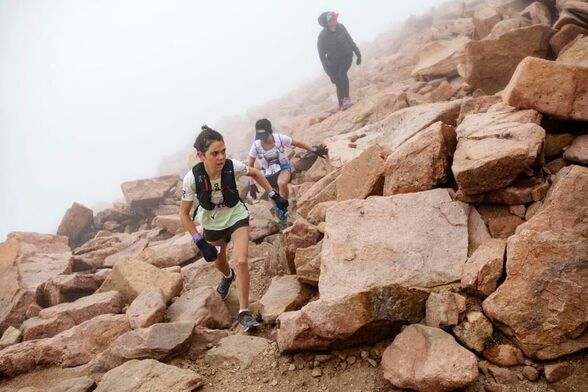Spencer McKeeSpencer is a 2021 Pikes Peak Ascent finisher (3:21:39) and writes for OutThere Colorado  Photo: Chancey Bush, Colorado Springs Gazette. Photo: Chancey Bush, Colorado Springs Gazette. From Pikes Peak Marathon, Inc. - New for 2022 are the gear requirements for the Pikes Peak Ascent and Marathon, one of which requires runners to carry a refillable water container. While many runners may have their hydration dialed in, there are many that may still have questions on what gear is best to carry. In this post, by Spencer McKee, you'll find tips for fuel and hydration along with ideas for the different types of gear . Don't forget to watch the video at the end from our partners at HydraPak! 8 Tips for Staying Fueled During the Pikes Peak Ascent or Marathon The Pikes Peak Ascent and Marathon races are fast approaching, sure to bring some of the best athletes from around Colorado and beyond to the Colorado Springs region. When it comes to properly fueling and hydrating on race day, here are a few things to remember: Note from the author: I'm not a nutritionist, I'm just a runner writing from my own limited experience on the trail. None of this advice is coming from a medical expert and consulting a medical expert is always recommended prior to taking any new supplement or vitamin. 1. Space is limited, pack accordingly. In a mountain race scenario, limiting weight and ensuring the proper pack balance can be crucial for an efficient and comfortable run. Bring too much in the pack and excess weight might feel like it's holding you back. Have awkward items in your pack and it can throw off your natural stride. Pack your race kit as you plan to do so on race day and take it on a few practice runs in weeks leading up to the big day. This way, you'll know how it feels prior to stepping foot on Barr Trail and can make adjustments if needed, including switching up your approach to fuel and fluids. 2. Pick the right pack for you. As with any type of outdoor recreation gear, there are countless options and everyone will have their own opinion in regard to what the right call is. The most important part of selecting a pack is that you're picking one that fits your specific needs. When it comes to the Pikes Peak Ascent and Marathon, many people tend to go with a backpack-style pack that will have easy-to-access hydration. Two companies I love for this type of pack are USWE (known for packs that reduce a lot of the annoying bounce) and Salomon (known for their cinching system on running packs that allows for the perfect fit). Looking to cut weight and go with something smaller? Something like the Nathan Marathon Pak won't hold hydration, but it will hold some fuel comfortably around your waist. Couple this with a handheld hydration option (like those from HydraPak), and make sure to refill at hydration stations along the way. 3. Don't skip the electrolytes. Did you know that hydrating with only water can result in something called hyponatremia? In other words, low blood sodium that can mimic some symptoms of altitude sickness. As you're sweating a lot, your body is losing a lot more than just water. Adding an electrolyte drink into the mix will help keep your body balanced. At the same time, only consuming electrolyte drinks can leave the body feeling funky. Many runners prefer to mix it up and drink both water and a special drink mixture throughout the race. A few great brands to turn to when it comes to finding an electrolyte drink option include Tailwind Nutrition (made in Durango), Liquid I.V., and nuun nutrition. Each of these companies offer a range of products. Pick what seems to work best for you. 4. Don't forget to consume some calories. Whether you're running the Pikes Peak Ascent or the Marathon, you'll be burning a ton of calories that you'll need to replenish some of those calories to prevent 'bonking' or hitting a wall in terms of exertion. Caloric drinks can help, but that's probably not enough. Most runners turn to gels, gummies, and other sources of nutrition that are packed with carbohydrates (and a bunch of other great stuff, like sodium) to keep their energy levels high. A few options I've used successfully in the past include CLIF BLOKS Energy Chews, GU Energy Gels, Science in Sport Energy Gels, and Honey Stinger Waffles. When it comes to eating during a race, there always seems to be a chance it will throw your digestive system out of whack mid-run. To prevent this, test your fuel on another long run before race day to see what best fits your own stomach. Some people prefer something that's chewy, others prefer a paste, while others like something that's more fluid. A lot of it comes down to the individual runner. In general, I prefer to simply have some sort of supplement I can actually look forward to eating, especially when facing off with a higher elevation that can seem to limit appetite. It's also got to be something that's easy to consume while moving. Try a few options and find the best fit for you. 5. Caffeine can be your best friend or worst enemy Many athletes rely on caffeine on race day for a quick and effective energy boost, but too much caffeine can result in nausea and dehydration. It can be tempting to keep putting more caffeine into the body to get more energy, but that's a fuse that burns quickly. As with any type of nutrition or gear, it's important to test a variety of techniques and methods to determine what's best for you. I try to make sure I never exceed 300 milligrams of caffeine during race day by switching between some supplements that have caffeine and others that don't. 6. Don't skip the aid stations During race day excitement, it can be easy to blow by aid stations found along a course. Obviously, there's no need to stop at every single aid station if you don't need to, but it's also important not to skip aid stations when you need them, thinking it will help your finish line time. Take breaks for fuel and hydration along the way when you need them and you'll end up feeling better and performing better overall despite falling a few seconds back here or there. 7. A salt pill might prove helpful, too. A number of companies sell salt pills branded toward runners to help prevent the negative side effects of low sodium levels. It might not be a bad idea to toss one or two in your pack. However, when it comes to sodium, make sure you don't overdo it. Stick to recommendations on the package. 8. Consult a nutritionist I'm no nutritionist, I'm just a runner that's tried a variety of options throughout my own personal running experience. If you want expert advice that will deliver the best results for your own body, consult a nutritionist. It's also important to consult a doctor prior to trying new supplements and vitamins. HydraPak Hydration Video Comments are closed.
|
©
Pikes Peak Marathon

